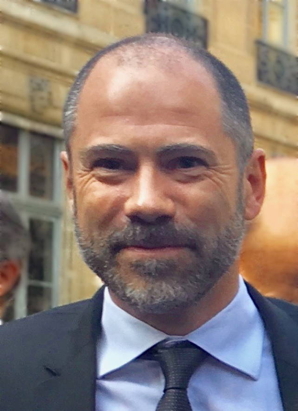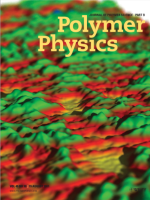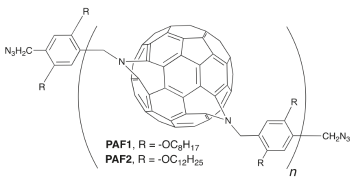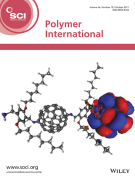
Roger HiornsDirecteur de Recherche CNRS
- Polymer Chemist for Organic Photovolatics, Energy Harvesting and Bio-electronics
- Chair, IUPAC Subcommittee on Polymer Terminology
- Associate Editor, Polymer International
 IPREM - UMR 5254 UPPA/CNRS - EPCP -
IPREM - UMR 5254 UPPA/CNRS - EPCP -
Technopole Helioparc - 2, av. Pdt P. Angot - 64 053 PAU cedex 09 polymer synthesis ; block copolymers ; poly(fullerene) ; fullerene chemistry ; organic photovoltaics ; energy harvesting ; graphene
polymer synthesis ; block copolymers ; poly(fullerene) ; fullerene chemistry ; organic photovoltaics ; energy harvesting ; graphene roger.hiorns @ univ-pau.fr
roger.hiorns @ univ-pau.fr +33 (0) 760 096 736
+33 (0) 760 096 736
Education
Professional Experience
|
since 2019 |
Directeur de Recherche CNRS, IPREM (CNRS/UPPA UMR-5254) |
|
2009 -2019 |
Chargé de Recherche CNRS, First class, IPREM (CNRS/UPPA UMR-5254) |
|
2007 - 2009 |
Ingénieur en Sciences des Polymères CNRS, LCPO, ENSCPB, IPB Syntheses of block copolymers for photovoltaic applications |
|
2002 - 2006 |
Ingénieur en Sciences des Polymères, LPCP, Université de Pau. |
|
2000 - 2002 |
Post-doc, LPCP, Université de Pau.
|
Education
|
2011 |
Habilitation à Diriger des Recherches (HDR), Université de Pau et des Pays de l’Adour |
|
1994-1998 |
Cotutelle PhD (UK)and Doctorat (France), |
|
1993 - 1994 |
MSc, Materials Chemistry, University of Kent (UK). |
|
1986 - 1989 |
BSc (Hons), Chemistry, University of Birmingham (UK).
|
Additional Experience
|
1998-1999 |
Editorial Assistant for the Society of Chemical Industry, London |
|
1989-1993 |
Photographer and b/w printer for the national press (Independent, The Guardian, Times, Daily Mirror etc.) |
Responsabilities
- PhD and post-doctoral supervisor
- Project Coordiantor, Leader and Participant for Horizon2020, National, Regional and Local grants
- Referee for International and National grant programs such as IUPAC, Horizon2020 ERC, ANR, etc.
- Referee for a wide range of scientific journals such as Nature, Advanced Materials, Macromolecules, etc.
- Samsung IUPAC Young Polymer Scientist Jurist
- PhD Jurist
Skills
- development of donor-acceptor block copolymers for photovoltaic applications
- development of new synthetic routes to fullerene-based polymers
- conjugated polymer synthesis
- organic photovoltaics
- large, community-scale installation of organic photovoltaics
- outreach work for schools and colleges for organic photovoltaics
Research interests
Our research is in two key areas.
- Developing new donor-acceptor block copolymers for organic photovoltaics.
These are both fullerene and non-fullerene based.
- Discovering new routes to polymerizing fullerene (C60) to make poly(fullerene)s
Through world-wide collaborations with leading industrial and key academic partners, we discover new materials for organic photovoltaic and bio-electronic applications.
- Syntheses of Block Copolymers for Organic Photovoltaics
- Syntheses of Poly(fullerene)s
- Organic Photovoltaic (OPV) Installations / Installations Photovoltaïques Organiques
- IUPAC – Subcommittee on Polymer Terminology
Syntheses of Block Copolymers for Organic Photovoltaics
These systems are expected to provide extremely high efficiencies due to their ability to self-assembly into nano-scale structures that are perfect for charge generation. They are also expected to give extremely high stabilities due to their interwoven macromolecular structures, indeed when used as additives in bulk-heterojunction devices they can both increase efficiencies by around 40% and improve stabilities.
In close collaboration with Prof. Didier Bégué (IPREM), we are working on various systems, ranging from those based on hexabenzocoronenes and polythiophenes, as shown below, to more complex systems.
Left, the molecular structure of part of an hexabenzocoronene-block-polythiophene copolymer, middle, its planar interactions between macromolecules, and right, the final calculated, columnar structure observed from above.
References include:
‘Main-Chain Poly(fullerene) Multiblock Copolymers as Organic Photovoltaic Donor-Acceptors and Stabilizers’, M. Raissi, H. Erothu, E. Ibarboure, H. Bejbouji, H. Cramail, E. Cloutet, L. Vignau, R. C. Hiorns, J. Mater. Chem. A. 2017, 5, 7533-7544. DOI: 10.1039/C7TA01980G.
‘Graphene-based acceptor molecules for organic photovoltaic cells: a predictive study identifying high modularity and morphological stability’, D. Bégué, E. Guille, S. Metz, M.-A, Arnaud, H. Santos-Silva, M. Seck, P. Fayon, C. Dagron-Lartigau, P. Iratçabal, R. C. Hiorns, RSC Advances, 2016, 6, 13653-13656. DOI: 10.1039/C5RA25531G.
‘Block Copolymer Strategies for Solar Cell Technology’, P. D. Topham, A. J. Parnell, R. C. Hiorns, J. Polym. Sci. Pt B Polym. Phys., 2011, 49, 1131-1156.
Syntheses of Poly(fullerene)s
Fullerene (C60) was discovered in 1985, and it shows an exceptional ability to eat-up and conduct electrons. This property is exploited in organic photovoltaic devices (OPVs) and is of interest for medical and bio-electronic applications.
We’re researching how C60’s can be incorporated into polymer chains. The chemistry we perform, targeting a variety of poly(fullerene)s, aims to better control C60‘s morphological, electronic and optical properties. Making C60 part of a chain has two effects: its self-assembly behaviour changes; and its electronic properties – the energies and positions of its orbitals – are modified. Both these variables can be changed by choosing the type of chemistry used.
Much of our work is done in close collaboration with Prof. Didier Bégué who has done a great deal in theoretical chemistry to help us understand and optimise the materials that we make.
Discoveries
i) ATRAP
We discovered the so-called atom transfer radical addition polymerization (ATRAP) of C60 several years ago in Bordeaux. This simple chemistry exploits a radically active comonomer to give highly regio-regular oligomers and polymers incorporating C60 directly into the main-chain. In Pau and with our partners, we’ve recently extended ATRAP to C60 derivatives, such as the widely used phenyl-C61-butyric acid methyl ester (PCBM). The reaction below shows the general methodology for the ATRAP reaction with PCBM to form an oligomer that we’ve called OPCBMMB.
References
‘Synthesis of Donor-Acceptor Multiblock Copolymers Incorporating Fullerene Backbone Repeat Units’, R C. Hiorns, E. Cloutet, E. Ibarboure, A. Khoukh, H. Bejbouji, L. Vignau, H. Cramail, Macromolecules, 2010, 43, 6033-6044.
This article was selected by Synfacts 2010, 10, 1127-1127, as one of the most significant works in the field of ‘Synthesis of Materials and Unnatural Products’.
‘Main-chain fullerene polymers for organic photovoltaics’, R. C. Hiorns, E. Cloutet, E. Ibarboure, L. Vignau,N. Lemaitre, S. Guillerez, C. Absalon, H. Cramail, Macromolecules, 2009, 42, 3549-3558.
‘In-situ generation of fullerene from a poly(fullerene)’, Hugo Santos Silva, Hasina H. Ramanitra, Bruna A. Bregadiolli, Aurélien Tournebize, Didier Bégué, Simon Dowland, Christine Lartigau-Dagron, Carlos F. O. Graeff, Andreas Distler, Heiko Peisert, Thomas Chassé, Roger C. Hiorns, Journal of Polymer Science, Pt B, Polymer Physics, 2019, 57, 1434-1452.
ii) SACAP
We also discovered another way of polymerizing C60. The sterically controlled azomethine ylide cycloaddition polymerization (SACAP) of C60 exploits Prato chemistry to yield soluble, highly modular and modifiable polymers and opens up a route to creating new materials with crafted morphological and opto-electronic properties. With our partners, we’ve recently found that these materials are of exceptional interest for OPVs and we’re looking to extend their use to other applications such as perovskites. PCBM can also be polymerised by SACAP. The new material, named PPCBMB, has a molecule weight of several tens of thousands of g mol-1. It has a high solubility and can be solution cast to form thin films. It also has raised LUMOs.
References
‘Sterically Controlled Azomethine Ylide Cycloaddition Polymerization of Phenyl-C61-butyric Acid Methyl Ester’, Meera Stephen, Hasina H. Ramanitra, Hugo Santos Silva, Simon A. Dowland, Didier Bégué, Kristijonas Genevičius, Kęstutis Arlauskas,Gytis Juška, Graham E. Morse, Andreas Distler, Roger C. Hiorns, Chem. Comm., 2016, DOI:10.1039/C6CC01380E.
‘Synthesis of Main-chain Poly(fullerene)s from a Sterically Controlled Azomethine Ylide Cycloaddition Polymerization’, Hasina H. Ramanitra, Hugo Santos Silva, Bruna A. Bregadiolli, Abdel Khoukh, Craig. M. S. Combe, Simon A. Dowland, Didier Bégué, Carlos F. O. Graeff, Christine Dagron-Lartigau, Andreas Distler, Graham Morse, Roger C. Hiorns, Macromolecules, 2016, 49(5), 1681, DOI: /10.1021/acs.macromol.5b02793.
iii) BAP
And yet another way of polymerizing fullerene! Here we’ve exploited azide chemistry to give red-wine coloured poly(fullerene)s.
Organic Photovoltaic (OPV) Installations / Installations Photovoltaïques Organiques
In a complete reversal, as a major step-change in technology, based on tried-and-tested installations at the German Pavilion, EXPO 2015 in Milan, and at the African Union’s building for “Security and Peace” in Addis Ababa, OPVIUS, now Armor Solar Power Films GmbH and its partners, the Communauté des Communes de Vic-Montaner (CCVM), and the Institut des Sciences Analytiques et de Physico-chimie pour l’Environnement et les Matériaux (IPREM), are proving that things can be done differently: photovoltaics performing as multi-functional components in new buildings and renovations while respectfully adapting to the needs of local aesthetics. The installations will show that OPV can play an important role in delivering safe and reliable clean energy, as well as providing a protective and educative role in supporting our communities and daily lives.
The CCVM is convinced that OPV can be integrated harmoniously and respectfully into the public environment, producing renewable energy and offering shade from sun, rain and hail, in community-scale installations, making it a perfect fit to the weather conditions in south-west France. The CCVM teamed up with local partners to explore the creation of local industries to deploy these new OPVs in a style that confirms and integrates seamlessly with local needs. The teaming process was led by the IPREM, an institute run by the CNRS and the Université de Pau et des Pays de l’Adour, and involved in OPV research and development, and well placed through its coordination of European networks to access the right partners for this action.
The range of the projects, from shaded walkways, church-yards, and public shopping malls, will demonstrate the way in which OPV can adapt to local aesthetics and needs. All the projects, despite their being commercial in nature, will be used to train local partners in the deployment of OPV in integrated projects, setting the base for the subsequent creation of an OPV industry based on the distinctive advantages of Armor’s technology based on a unique manufacturing process, combining printing, lamination and laser structuring technologies, allowing high scalability and the implementation of custom designs.
We believe that OPV will play an important role in our energy sourcing of tomorrow. To have these installations near-by will allow us to strengthen our research and development base, testing our materials in a safe and in a real-life environment. This will be directly relevant for future projects and for the education of our students, giving them a good chance to develop high-tech jobs in this region. We’re looking forward to expanding our science education and outreach projects with local communities and schools.
More information can be found at:
https://www.sudouest.fr/pyrenees-atlantiques/pau/photovoltaique-la-revolution-est-lancee-3493419.php
IUPAC – Subcommittee on Polymer Terminology
The IUPAC Subcommittee on Polymer Terminology (SPT) is responsible for recommending universally recognizable definitions of terms for polymer science, and rules for unique identifications of polymers. The latter is done on behalf of the IUPAC Division VIII for Chemical Nomenclature and Structure Representation. SPT’s publications are freely available in the journal Pure and Applied Chemistry and are brought together in the Purple Book. They are of use for education, scientific literature, and patents.
It has drawn on numerous, extraordinary talents and represents the single highest world-wide forum to discuss questions on polymer terminology and nomenclature. Its recommendations are used by most of the world’s governmental and NGO organizations, for example, the EEC, the UN and UNESCO.
SPT used to be called the Commission on Macromolecular Nomenclature and was formed in the 1960s. In 1999 it changed its name to the Subcommittee on Macromolecular Terminology, and then again to its current appellation. It is formed of around 30 to 40 members from countries all around the world, and meets once per year. Electronic exchanges play an increasing role in its deliberations but face-to-face negotiations are still used as they facilitate faster, more comprehensive exchanges.
Useful reference
‘A Brief Guide to Polymer Nomenclature’, R. C. Hiorns, R. J. Boucher, R. Duhlev, K.-H. Hellwich, P. Hodge, A. D. Jenkins, R. G. Jones, J. Kahovec, G. Moad, C. K. Ober, D. W. Smith, R. F. T. Stepto, J.-P. Vairon, J. Vohlídal, Pure and Applied Chemistry, 2012, 84, 2167.
Projects
Project Coordinator Responsible for total awards around 4.2 M€ for 8 projects at International, EEC, and Regional levels, including ESTABLIS. Please see www.project-establis.eu for more information about this FP7-PEOPLE-ITN project that ran from 2012-2015.
Project Participant for a futher 8 projects at inetrnational and national levels.















